Last updated on April 25th, 2022 , 07:29 am
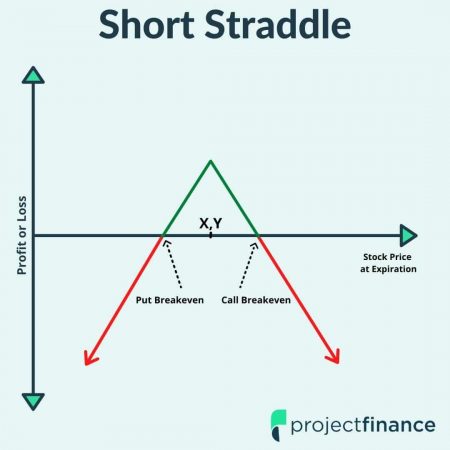
Jump To
In this article, we’ll examine the historical performance of selling straddles on the S&P 500, and the impact of closing trades using profit targets and stop-losses.
What is a Short Straddle?
A short straddle is an options strategy constructed by simultaneously selling a call option and selling a put option with the same strike price and expiration date. Selling a straddle is a directionally-neutral strategy that profits from the passage of time and/or a decrease in implied volatility. A trader who sells a straddle is anticipating the stock price to stay close to the straddle’s strike price in the near future, as the options that were sold will experience the most extrinsic value decay as expiration approaches.
For instance, if a stock is trading at $100 and the trader wants to sell the 100 straddle with 30 days to expiration, they’d sell the 100 call option and 100 put option in the expiration nearest to 30 days.
The Risk of Selling Straddles
The most a trader can make when selling a straddle is the amount of option premium collected for selling the straddle, while the loss potential is virtually unlimited.

New to options trading? Learn the essential concepts of options trading with our FREE 160+ page Options Trading for Beginners PDF.
Short Straddles on the S&P 500
Instead of just looking at the results of holding the short straddles to expiration, we’ll examine the usage of stop-losses as well to see if closing losing trades has improved the strategy’s performance over time.
NOTE: as opposed to a stop-loss order, a stop-limit orders guarantee a fill price.
Study Methodology
Product: S&P 500 ETF (SPY)
Expiration: Standard monthly cycle closest to 60 days to expiration (60 DTE).
Trade Setup: Sell the at-the-money call and put.
Management: None (hold to expiration), -50% loss, -100% loss, -150% loss.
Next Entry Date: First trading day after previous trades were closed.
Stop-Loss Example
To make sure you understand the stop-loss calculations, here are some examples:
Initial Straddle Sale Price: $10
-50% Loss: Straddle price increases by 50% to $15.
-100% Loss: Straddle price increases by 100% to $20.
-150% Loss: Straddle price increases by 150% to $25.
The stop-loss is just the percentage increase over the initial sale price that is used as a trigger to close the trade.
SPY Short Straddles: Taking Losses
Here are the results of the first study:
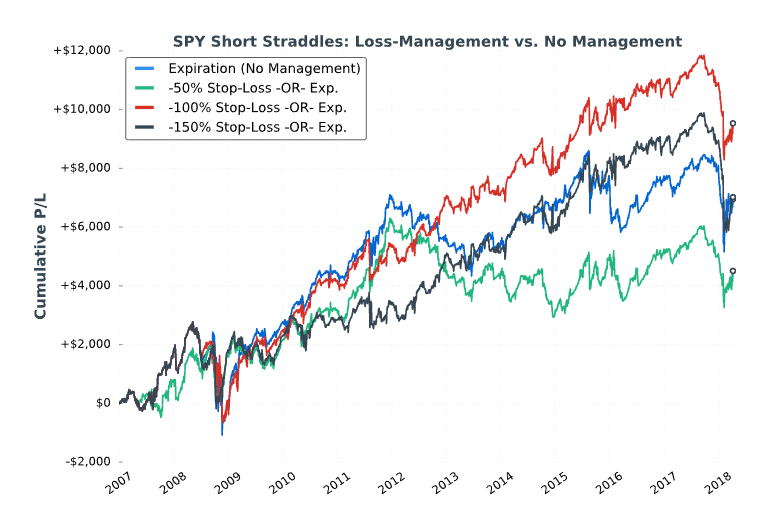
*Please Note: Hypothetical computer simulated performance results are believed to be accurately presented. However, they are not guaranteed as to the accuracy or completeness and are subject to change without any notice. Hypothetical or simulated performance results have certain inherent limitations. Unlike an actual performance record, simulated results do not represent actual trading. Also, since the trades have not actually been executed, the results may have been under or over compensated for the impact, if any, or certain market factors such as liquidity, slippage and commissions. Simulated trading programs, in general, are also subject to the fact that they are designed with the benefit of hindsight. No representation is being made that any portfolio will, or is likely to achieve profits or losses similar to those shown. All investments and trades carry risk.
Compared to holding to expiration, implementing a stop-loss that was not too tight helped smooth out strategy returns. By using the smallest stop-loss and closing trades when the loss reached 50% of the premium received, the returns were choppy and inconsistent over the test period.
Visually, the best-performing approach was to use a -100% stop-loss, which means the short straddles were closed if the price doubled from the initial entry price.
With that said, all approaches suffered significant losses in February of 2018, which highlights the importance of keeping risk in mind before selling straddles.
Here are some performance metrics related to each management approach:
Trade Results
As expected, the -50% stop-loss level had a lower success rate compared to the other approaches. If you’re wondering how the -100% stop-loss level had a higher success rate than not taking losses at all, it’s because closing trades early results in more overall trades, which can sometimes lead to higher percentages of profitable trades compared to the approaches with fewer trades.
Also, it’s worth noting that the losses were sometimes far more than the stop-loss levels in each category, which can be explained by the fact that sometimes trades will not be able to be closed at the exact stop-loss levels. The losses were sometimes much more than the stop-loss levels because the study uses end-of-day data, which means substantial one-day market movements can lead to a large change in the option prices by the time the market closes.
How many of the short straddles reached each loss level?
Not many of the straddles reached the -100% P/L level, but the same percentage reached the -100% and -150% P/L levels. The data shows us that almost all of the straddles that reached the -100% loss level also reached the -150% loss level. The data suggests that using a stop-loss of -100% is strategically better than using a slightly wider stop-loss of -150%.
SPY Short Straddles: Taking Profits
Now that we’ve explored the usage of stop-losses when selling straddles, let’s look at the historical performance implications of closing profitable straddles early. The preferred order type to do this is the limit order.
We’ll use the same methodology as before:
Sell an at-the-money SPY straddle in the expiration closest to 60 days.
Management: None, 10% Profit Target, 25% Profit Target, 50% Profit Target.
Next Entry Date: First trading day after previous trades were closed.
For instance, if a straddle was sold for $10, a 10% profit would be reached when the straddle’s price decreased to $9 (a 10% decrease from the entry price). A 25% profit would be reached when the straddle’s price decreased to $7.50 (a 25% decrease from the entry price).
Here were the results:
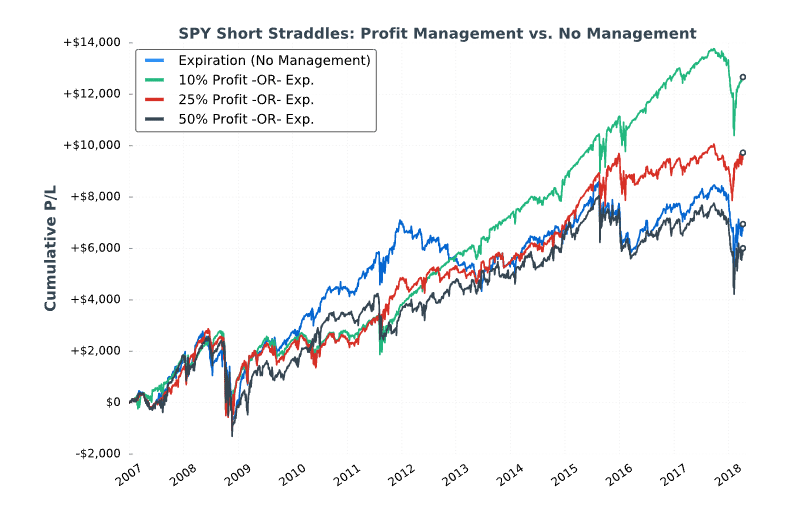
*Please Note: Hypothetical computer simulated performance results are believed to be accurately presented. However, they are not guaranteed as to the accuracy or completeness and are subject to change without any notice. Hypothetical or simulated performance results have certain inherent limitations. Unlike an actual performance record, simulated results do not represent actual trading. Also, since the trades have not actually been executed, the results may have been under or over compensated for the impact, if any, or certain market factors such as liquidity, slippage and commissions. Simulated trading programs, in general, are also subject to the fact that they are designed with the benefit of hindsight. No representation is being made that any portfolio will, or is likely to achieve profits or losses similar to those shown. All investments and trades carry risk.
Taking profits at 10-25% of the maximum profit potential significantly increased the consistency of returns relative to not managing trades at all.
As expected, taking profits sooner resulted in higher success rates, fewer days held, yet larger losses than holding to expiration.
The reason the losses are larger in the profit-taking approaches is simply because there’s more overall trades, which means the straddle’s strike price is more often reset to the current market price.
I explain why this matters in this video:
Pros and Cons of Closing Profitable Straddles
There are numerous benefits of closing short straddle positions before expiration for profits.
Benefit #1
‘Reset’ the strike price higher during steadily rising markets. Results in more neutralized position deltas over time and reduces the probability of loss from market increases. The same concept holds true for steadily declining markets.
Benefit #2
Reduce P/L Volatility by avoiding the high gamma exposure short straddles can have close to expiration (if the stock price is near the strike price).
Benefit #3
Higher percentage of profitable trades, which can be beneficial from a psychological standpoint.
It’s not all good when it comes to closing short straddles early. Here are the downsides of closing profitable trades sooner.
Con #1
Resetting the strike price closer to the current stock price is also a bad thing. After selling a straddle, a quick drop in the stock price will lead to larger losses relative to a scenario where the stock price rises above the strike price and then falls through the strike price (which is more likely when holding positions longer because the market typically drifts higher). Refer to the video above for a more in-depth explanation
Con #2
More trades = more commissions. By exiting trades quicker, new trades are opened sooner as well, which leads to significantly more trades over time (and therefore more commissions).
Con #3
Higher required success rate when taking smaller profits. By closing trades for small profits, more profitable trades are required to recoup the losses from unprofitable trades, especially if the loss far exceeds the chosen stop-loss.
Selling Straddles on the S&P 500: Combining Profit & Loss Management
Hopefully, you’ve learned a great deal about how simple profit-taking and loss-taking approaches can potentially improve performance when selling straddles.
Now, we’ll examine the historical performance of combining profit targets and stop-losses on short straddle positions.
Study Methodology
Product: S&P 500 ETF (ticker: SPY)
Expiration: Standard monthly cycle closest to 60 days to expiration.
Trade Setup: Sell the at-the-money call and put. One straddle sold for all trades.
Management:
✓ 10% Profit OR 50% Loss
✓ 25% Profit OR 50% Loss
✓ 10% Profit OR 100% Loss
✓ 25% Profit OR 100% Loss
For example, if a straddle was sold for $10 and a trader used the 25% Profit OR 50% Loss management, they’d close the straddle if the price reached $7.50 (a 25% profit) or $15 (a 50% loss).
Here were the results of the four short straddle management strategies:
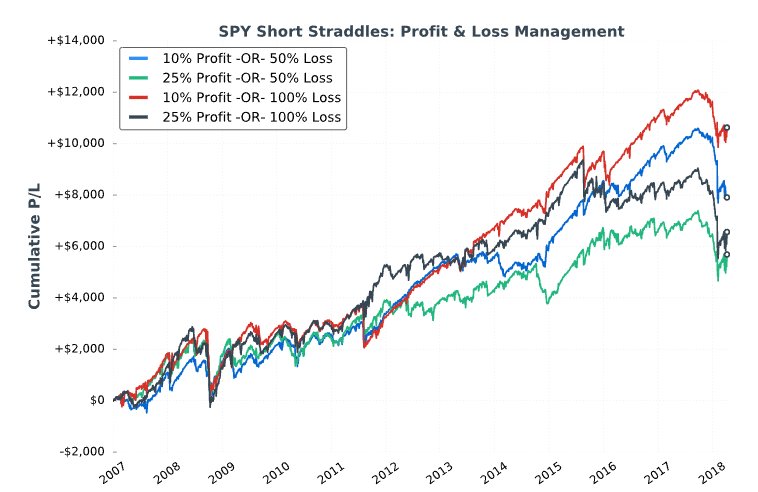
As we can see, all four of the management strategies performed well over the test period, though all strategies suffered major losses in February of 2018.
Consistent with previous findings, the 10% profit target approaches had the smoothest growth curves over time, as short straddles rarely get to higher profit percentages (since that requires the stock price to remain right on the straddle’s strike price as time passes).
As expected, taking profits earlier resulted in higher success rates and fewer days held, but larger drawdowns on the worst trades. The reason is partly because there’s more overall trades when taking profits sooner, but also because the strike price is reset more often.
How did the 10% profit-target approaches compare to not managing trades at all?
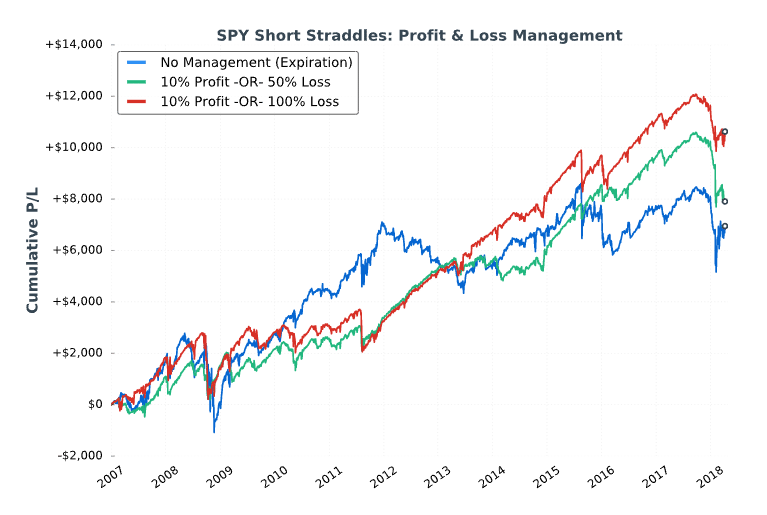
Holding short straddles to expiration had a period of outperformance between 2009-2012, but lagged behind the management approaches and was much less consistent during the 2012-2018 period.
During the 2009-2012 period, the VIX Index (implied volatility of S&P 500 options) was incredibly high and decreasing quickly in the years after the 2008 market collapse. A quickly decreasing VIX Index is a favorable environment for short premium strategies, as profits can occur very quickly. Consequently, taking small profits lagged behind letting the trades run until expiration.
However, during lower implied volatility environments (such as 2013 to early 2018), taking off profitable trades sooner led to much more consistent results compared to holding to expiration. It makes sense, as the market is typically grinding higher during low implied volatility environments (which is why implied volatility is low).
Here’s the same chart from above but with the VIX Index plotted against the strategies:
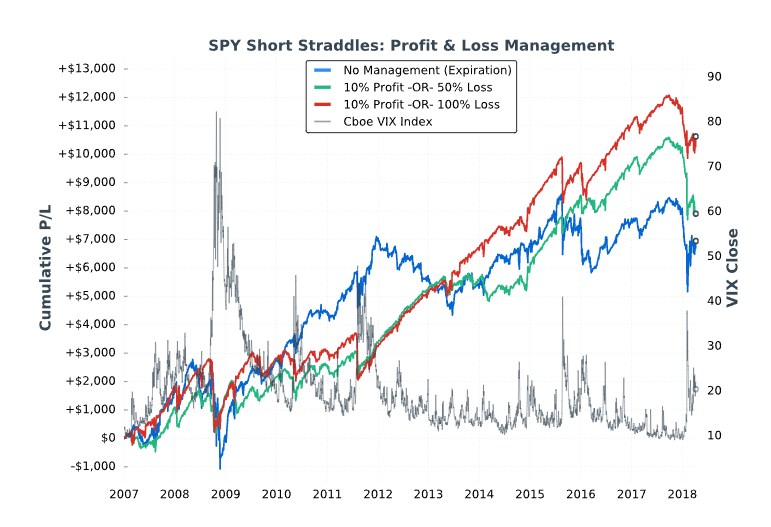
It’s important to note that while all of the above approaches show profits after the entire test period, all approaches suffered substantial losses at times, especially during February of 2018.
Over a long enough period of time, there will be market crashes worse than what was experienced in 2008, 2015 and 2018.
With that said, short straddles carry substantial risk and should be implemented with extreme caution (if at all). Undefined-risk strategies like short straddles and strangles are far riskier than what most traders are comfortable with, especially when increasing trade size.
Always think about risk before making any trades, and keep in mind that losses can become severe very quickly when selling naked options.
Short Straddle FAQs
Short straddles are typically adjusted by either rolling the options to a different expiration cycle or rolling the options to a different strike price. A combination of these two strategies is possible too.
Since the short straddle involves a short call option, ,the risk in this strategy is unlimited. A trader may use an alternate strategy, such as the iron condor, to mitigate risk.
projectfinance Options Tutorials

About the Author
Chris Butler received his Bachelor’s degree in Finance from DePaul University and has nine years of experience in the financial markets.
Chris started the projectfinance YouTube channel in 2016, which has accumulated over 25 million views from investors globally.





